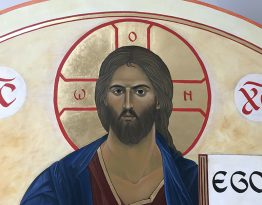If you have recently been watching the livestreamed daily Masses from St. John’s Abbey in Collegeville, you likely have noticed something new in the Abbey Church.
It’s hard to miss the 12-foot-by-7-foot icon of Christ Pantocrator (Ruler of All Things) above the abbot’s chair. The icon, completed just in time for Holy Week, was written by Benedictine Father Nathanael Hauser.
“Two years ago, a semi-circular painting of the Nativity was placed above the abbot’s throne for the Christmas season,” said Father Hauser, a member of the abbey. “The success of the placement of that image led to the proposal to paint a new image of similar size suitable for the Easter season.”

The icon was created in the spirit of the mural of Jesus Christ in the Abbey’s Great Hall that was painted by Benedictine Brother Clement Frischauf (1869-1944), who also painted the Nativity. But Father Hauser decided not to copy the Beuronese style of the mural. The icon is written in a contemporary style, he said.
The Scripture text is the same as the mural in the Great Hall — “Ego Sum Via, Veritas et Vita” or “I Am the Way, the Truth, and the Life.”
Father Hauser has been painting icons since the mid 1970s. When he first became interested in icons, there were no books or courses in English, he said, so he had to figure it out the best he could. In the 1980s, while studying theology in Rome, he spent a summer in France studying iconography under the late Jesuit Father Egon Sendler, one of the world’s foremost experts on the painting of Eastern Orthodox icons.
Father Hauser has painted icons on a commission basis for individuals in Europe and the United States, usually painting in egg tempera. (Egg tempera means that the binder is the yolk of an egg, similar to how oil paint uses different oils, and acrylic paint uses plastic as the binder, Father Hauser said.)
“Because a wooden panel of such a large size would be extremely difficult to construct and would be very heavy, we decided to use canvas with a wooden frame which would be much lighter, allowing the work to be hung more easily,” Father Hauser said.
St. John’s Abbey Woodworking constructed the frame and also stretched the canvas, he said.
“Since using egg tempera was not possible with the canvas, I chose to use acrylic paint,” he said. “I spent a year painting smaller pieces in acrylic in order to discover how to use it to imitate the look and feel of a traditional egg tempera painting.”
Gold leaf was used, so the design of the icon had to be done before any paint was applied. This is different than the way many artists approach their work today, he said.
“With an icon, all of the design elements must be planned in advance,” Father Hauser said. “This icon took five months to complete, but three of those months were devoted to a number of full-size drawings to decide on the final composition.”
Once that was completed, it took two months to paint.
The icon will be up for the Easter season, which runs through Pentecost, Sunday May 31.






















You don’t paint an icon you write it.